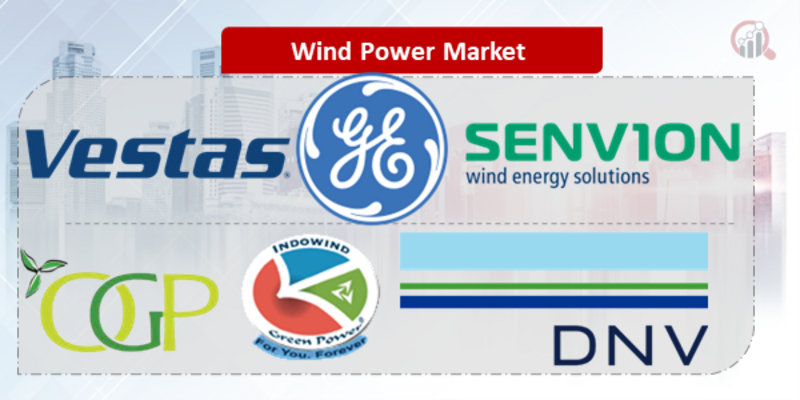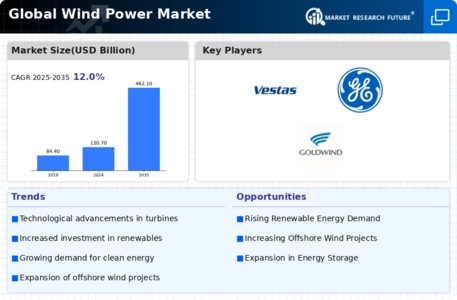Top Industry Leaders in the Wind Power Market

*Disclaimer: List of key companies in no particular order
The global wind power market is currently undergoing robust growth, propelled by increasing energy demand, diminishing costs associated with wind power generation, and ambitious renewable energy targets set by governments across the globe. This surge has led to a diverse influx of players, resulting in a competitive landscape characterized by both industry titans and innovative entrants.
Key Player Strategies:
Dominant Players: Industry leaders such as Vestas, Siemens Gamesa, GE Renewable Energy, and Goldwind stand out in the market with well-established global networks, extensive R&D capabilities, and a broad turbine portfolio. Key strategies include:
-
Product Line Expansion: Diversifying product portfolios to suit various wind conditions and project requirements. This involves developing larger turbines for offshore wind farms and smaller turbines for distributed generation.
-
Geographical Expansion: Concentrating efforts on emerging markets, particularly in Asia-Pacific and Latin America, where substantial growth potential exists.
-
Technology Advancements: Significant investments in research and development to create more efficient and cost-effective turbine technologies. This includes innovations in blade design, materials science, and grid integration.
-
Strategic Partnerships: Collaborating with local entities, technology providers, and project developers to leverage expertise and gain market access.
Emerging Players: Smaller, regional entities are challenging established players by focusing on niche markets, cost competitiveness, and innovative technologies. Their strategies include:
-
Specialization: Concentrating on specific turbine segments, such as small wind turbines, offshore wind turbines, or specialized technologies for challenging environments.
-
Cost Leadership: Optimizing manufacturing processes and supply chains to achieve lower production costs.
-
Technological Innovation: Investing in disruptive technologies like advanced materials, innovative blade designs, and digitalization solutions.
-
Mergers and Acquisitions: Pursuing strategic acquisitions to expand product portfolios, geographical reach, and market share.
Factors for Market Share Analysis:
-
Installed Capacity: The most common metric used to assess market share, reflecting the total capacity of wind turbines installed by a company.
-
Market Share by Region: Analysis of market share within specific regions provides insights into the competitive landscape in different markets.
-
Market Share by Segment: Evaluation of market share by segment, such as onshore vs. offshore wind, reveals a clearer picture of players' strengths in different areas.
-
Technological Leadership: Assessment of companies' R&D investments, patent portfolio, and innovative offerings provides insights into their potential for future growth.
-
Financial Performance: Analysis of revenue, profitability, and financial health helps assess the long-term sustainability of companies in the competitive market.
New and Emerging Trends:
-
Digitalization: Increasing adoption of digital technologies like AI, Big Data, and IoT is transforming the wind power industry, leading to improved operational efficiency, predictive maintenance, and optimized wind farm management.
-
Hybrid Power Systems: Integration of wind power with other renewable energy sources like solar PV and battery storage is gaining traction, offering a more stable and reliable source of clean energy.
-
Floating Offshore Wind: This technology allows wind farms to be installed in deeper waters, opening up vast new areas for wind energy development.
-
Local Manufacturing: To reduce costs and mitigate supply chain risks, companies are increasingly establishing manufacturing facilities in key growth markets like Asia and Latin America.
-
Circular Economy: The industry is exploring circular economy solutions to address the end-of-life challenges of wind turbines, promoting sustainable practices and minimizing waste.
Key success factors in this dynamic environment include:
-
Cost-Competitiveness: Offering competitive prices and demonstrating the economic benefits of wind power projects.
-
Technological Leadership: Continuous development and implementation of innovative technologies to improve efficiency and reduce costs.
-
Strong Project Execution: Successful management of the development, construction, and operation of wind farms to ensure timely delivery and high performance.
-
Financial Stability: Possessing the financial resources to invest in R&D, expansion, and acquisitions.
-
Global Reach: Having a strong international presence to tap into emerging markets and diversify geographic exposure.
The future of the wind power market is promising, with continued growth driven by supportive policy frameworks, technological advancements, and increasing demand for clean energy. Companies that can adapt to the changing landscape, embrace innovation, and remain competitive will be best positioned to thrive in this dynamic market.
Industry Developments and Latest Updates:
General Electric (US):
- Launched the Haliade-X 15 MW offshore wind turbine, the most powerful in the world, in May 2023. (Source: GE Renewable Energy website)
Vestas (Denmark):
- Secured new orders for Vestas-V174 turbines in Brazil and Sweden in October 2023. (Source: Vestas website)
Senvion SA (Germany):
- Announced a strategic partnership with China's Mingyang Smart Energy in July 2023, expanding its presence in the Asian market. (Source: Senvion website)
DNV GL (Norway):
- Published a report highlighting the potential of floating wind energy in Asia Pacific in October 2023. (Source: DNV GL website)










